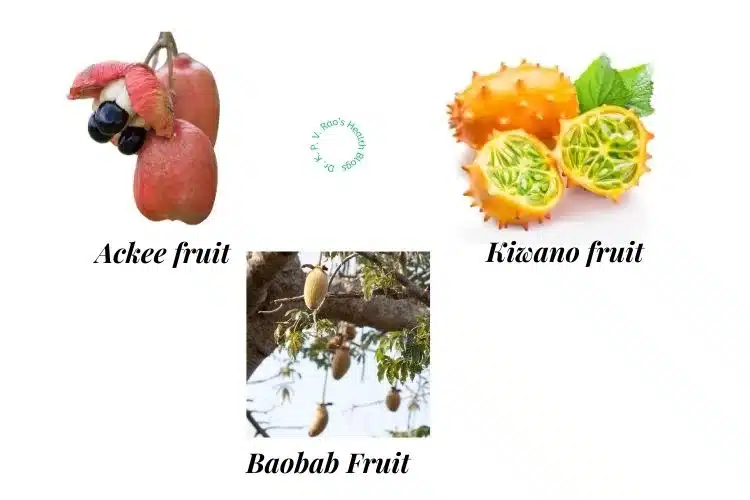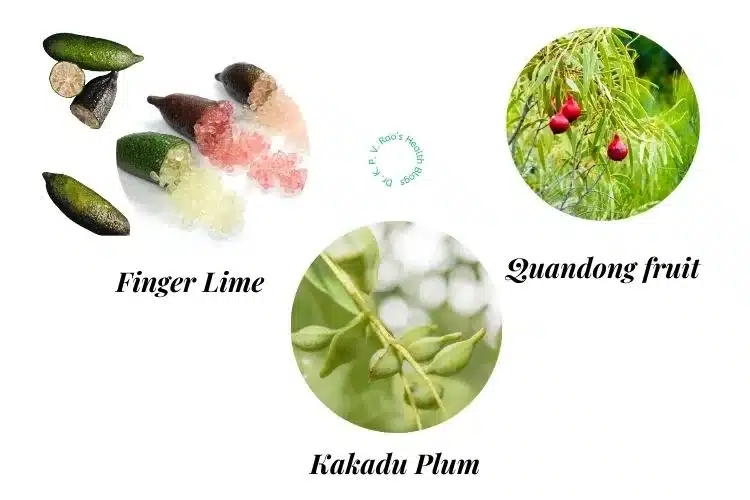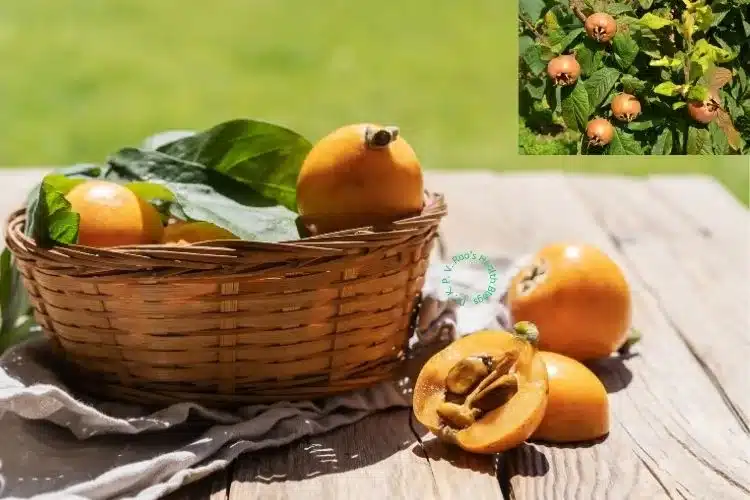Table of Contents
Introduction
In my last article on Exotic Fruits- Part 1, I discussed fruits from Asia and South America. In today’s article we discuss exotic fruits from Africa, Europe and Australia.
Why do we have to learn about these fruits?
In my quest for good health, I like to explore numerous ways to improve health and longevity. Apart from exercise, dietary habits and variation are what I explore. Trying out new fruits and vegetables is one of them.
In this article, I have mentioned some fruits, some of which I may have seen, eaten and relished. Most of them are new to me also. I have tabled this here after reading about their nutritive values and their health benefits, from various sources, so that you can get a ready reckoner-like insight about these fruits.
As mentioned in the previous article, the idea or purpose behind writing this article on exotic fruits is to educate and spread awareness to the readers about these fruits, where they are usually found, benefits of consuming them, thereby improving health and reducing or doing away with medicines in some diseases.
Exotic Fruits from Africa and West Indies
Baobab Fruit: Nature’s Vitamin C Bomb
Baobab fruit is generally found in Africa, particularly in countries like Senegal, Madagascar, and Tanzania. [See the picture below]
In 100 grams of the fruit, you can find approximately:
- 84 calories,
- 0.2 grams of fat, and
- 24 grams of carbohydrates.
It is also a good source of vitamin C as well, providing about 40 milligrams per 100 grams.
Some health benefits of baobab fruit include its high antioxidant content, which may help reduce oxidative stress, and its potential to support immune function and digestion.

Horned Melon (Kiwano): A Refreshing Tropical Surprise
Horned Melon, also known as Kiwano, is a fruit that is generally found in Africa and New Zealand.
In 100 grams of Horned Melon, we get:
- Calories: 44
- Carbohydrates: 9.61 grams
- Protein: 1.79 grams
- Fat: 0.35 grams
- Fiber: 2.8 grams
- Vitamin C: 5.3 milligrams
- Calcium: 13 milligrams
- Iron: 1.13 milligrams
Health benefits of Horned Melon include its high-water content, which helps with hydration, and its rich source of vitamin C, which boosts the immune system. It also provides dietary fiber that aids in digestion.
Ackee: The National Fruit of Jamaica
Ackee is the national fruit of Jamaica. It is typically found in tropical regions, and is ntive to West Africa. From here it was exported to Jamaica in West Indies, where it found its place in Jamaican dishes.
100 grams of the fruit contains approximately:
- 151 calories,
- 9 grams of fat,
- 15 grams of carbohydrates, and
- 2 grams of protein.
Some health benefits of ackee include providing essential nutrients like vitamin C, potassium, and fiber, supporting heart health, aiding digestion, and boosting the immune system.
This fruit is used as a vegetable.
Exotic Fruits from Australia and New Zealand
In this para, we will some of the exotic fruits native to Australia. Here is a picture of some of these fruits-

Finger Lime: The Caviar of Citrus
Finger Lime is a citrus fruit known as the Caviar of Citrus. It is primarily found in Australia. Here are the nutritional facts for 100 grams of Finger Lime:
- Calories: 29
- Carbohydrates: 7 grams
- Fiber: 3 grams
- Protein: 1 gram
- Fat: 0.4 grams
Finger Lime offers several health benefits, including being a good source of Vitamin C, antioxidants, and dietary fiber. It can support immune function, promote healthy skin, and aid digestion.
Kakadu Plum: The Vitamin C Powerhouse
Kakadu Plum is a fruit that is generally found in Australia. In 100 grams of the fruit, it contains approximately 3000-5000 milligrams of vitamin C, making it one of the richest natural sources of vitamin C.
Nutritional Value Per 100g serving of Kakadu Plum:
In 100 grams of this unique fruit, you can expect to find-
- Calories: 43
- Carbohydrates: 9.2g
- Fiber: 4.4g
- Protein: 1.4g
- Fat: 0.2g
- Vitamin C: 1000-5300mg
- Potassium: 180mg
- Calcium: 27mg
- Iron: 0.9mg
- Zinc: 0.1mg
- Sodium: 2mg
- Magnesium: 32mg
- Phosphorus: 27mg
It also contains antioxidants, iron, and other essential nutrients. Some of the health benefits associated with Kakadu Plum include
- boosting the immune system,
- enhancing skin health,
- supporting cardiovascular health, and
- promoting overall well-being.
Quandong: A Unique Bush Food
Quandong is a unique bush food native to Australia. It is generally found in arid and semi-arid regions, particularly in the central and southern parts of the country.
Here are the nutritional facts of Quandong per 100 grams of the fruit:
- Calories: 78
- Protein: 1.5 grams
- Fat: 0.3 grams
- Carbohydrates: 17.7 grams
- Fiber: 6.2 grams
Quandong offers several health benefits, including:
- High in antioxidants
- Good source of vitamin C
- Contains essential minerals like iron, magnesium, and calcium
- May have anti-inflammatory properties
- Has potential antimicrobial and antifungal properties
Please note that this information is general and should not replace professional medical advice.
Kiwi fruit
Kiwi fruit, also known as Chinese gooseberry, is found in various parts of the world. It is native to China but is now cultivated in countries like New Zealand, Italy, and the United States.
In terms of nutritional facts, here’s what you can find in 100 grams of kiwi fruit:
- Calories: 61
- Carbohydrates: 14 grams
- Fiber: 2.1 grams
- Protein: 1.1 grams
- Fat: 0.5 grams
- Vitamin C: 98 milligrams (163% of the daily recommended intake)
- Vitamin K: 40.3 micrograms (50% of the daily recommended intake)
- Potassium: 312 milligrams
- Folate: 25 micrograms
Eating kiwi fruit can have several health benefits, including:
- Boosting the immune system due to its high vitamin C content
- Improving digestion and reducing constipation because of its dietary fiber
- Supporting heart health by lowering blood pressure and reducing the risk of blood clots
- Enhancing skin health and promoting collagen synthesis
- Providing antioxidants that help protect against cell damage and reduce the risk of chronic diseases
In India, people recommend it to patients sufferring from malaria or dengue. It is known to boost the platelet count in the blood. Low platelet count is known to cause bleeding diorders, like internal bleeding, shock and sometimes, death.
Exotic Fruits from Europe
Medlar: A Forgotten Fruit with a Rich History
Medlar is a fruit that is generally found in Europe and some parts of Asia.

Nutritional value in 100 grams of Medlar fruit:
In 100 grams of Medlar fruit, you can expect to find
- approximately 83 calories,
- 4 grams of fiber,
- 1 gram of protein, and
- various vitamins and minerals including
- vitamin C,
- vitamin E, and
- potassium.
Some potential health benefits of Medlar include aiding digestion, boosting the immune system, and providing antioxidants.
Sloe Berry: The Key Ingredient for Sloe Gin
Sloe berry is the key ingredient for sloe gin. It is typically found in Europe, particularly in the United Kingdom.
In terms of nutritional facts, in 100 grams of the fruit, it contains approximately:
- 44 calories,
- 0.4 grams of fat,
- 9.6 grams of carbohydrates,
- 0.1 grams of protein, and 0.4 grams of fiber.
Some health benefits of sloe berry include its rich antioxidant content and potential anti-inflammatory properties.
Availability and Cost– Where to find these fruits and their Approximate cost per kilogram
Let’s now know how much these unique fruits cost and where they are available.
Exotic Fruits and Their Approximate Cost per Kilogram in dollars [or its equivalent in local currency]:
Dragon Fruit (Asia) – Approximately $5 per kilogram
Durian (Asia) – Approximately $10 per kilogram
Passion Fruit (South America) – Approximately $3 per kilogram.
Kiwano (Africa) – Approximately $6 per kilogram.
Rambutan (Asia) – Approximately $4 per kilogram.
Persimmon (North America) – Approximately $8 per kilogram.
Mangosteen (Asia) – Approximately $12 per kilogram.
Physalis (South America) – Approximately $7 per kilogram.
Horned Melon (Africa) – Approximately $9 per kilogram.
Please note that these prices are approximate and may vary depending on the region and availability.
Conclusion
I conclude my article here. Hope you have learned a few new insights into the “world of exotic fruits” and hope you try them out whenever you get a chance- I definitely would not miss the chance.
Do look out for these unique fruits if you visit any of the countries I have mentioned in this article. If you have enjoyed what you have read, do consider sharing it with your friends and family members using the icons below. Alternately, you can Click to Tweet here-
Exotic fruits from around the world-Part 2 Share on XAdios.




